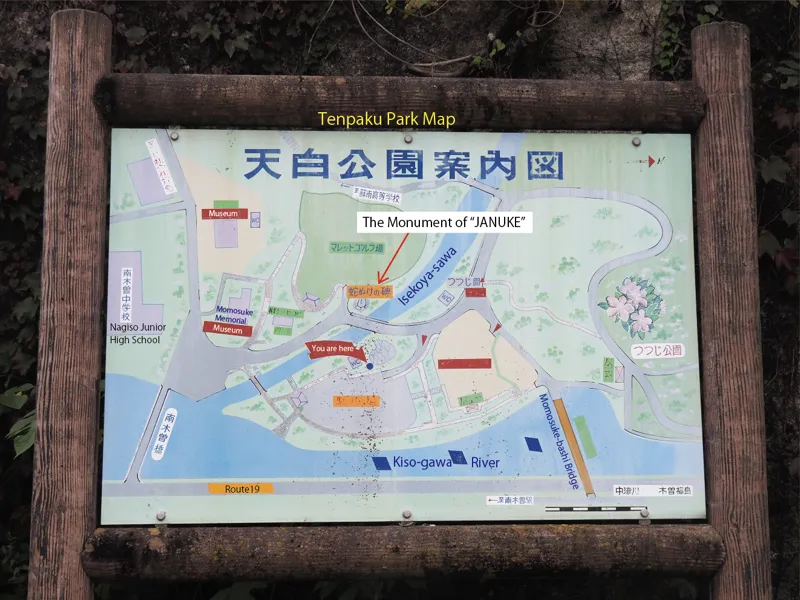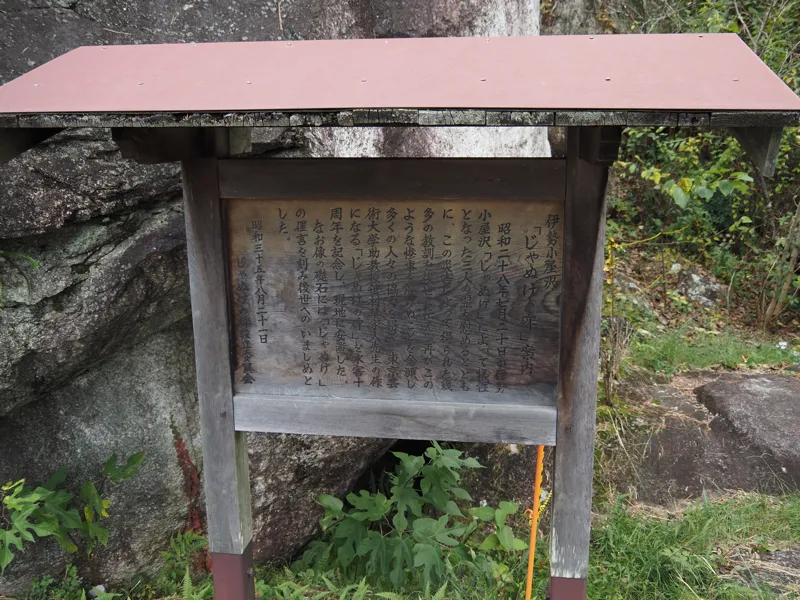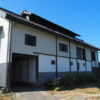Monument of “Januke”
The area where Momosuke-bashi Bridge and the Momosuke Fukuzawa Memorial Museum are located was maintained as Tenpaku Park. The photo is an information map of the park.
The Kiso-gawa River flows horizontally in the lower part of the map, and its tributary, which joins the river diagonally, is named Isekoya-sawa River.

The map shows that there is a “monument of Januke” on the bank of Isekoya-sawa. “Januke” is a word used in the Kiso region to describe a ”mudflow".
Let’s check what kind of monument it is, since it will be related to a disaster.
The entirety of the monument is photographed. There is a concrete statue in the upper right corner, an explanatory board in the lower right corner, and a stone with a carved lyric on the left side.

First, I checked the explanatory board on the right side, which reads as follows.

“Isekoya-sawa 'Monument of Januke’ Guide
In commemoration of the date of the July 20, 1953 flood in Isekoya-sawa, a monument was built by Sokajin Sasamura, an assistant professor at Tokyo National University of Fine Arts and Music, with the cooperation of many people to comfort the spirits of the three victims of the Isekoya-sawa 'Januke’ disaster and to pass on to future generations the many lessons learned from this disaster, in hopes that such a disaster will not occur again. The monument was placed at the site to pry the 10th anniversary of the mudflow.
On the cornerstone of the statue, the proverb about 'Januke’ was engraved as a reminder to future generations.
August 21, 1960
Monument of Januke Establishment Committee"
(1) “Januke" outbreak
On July 20, 1953, a three-day long rainstorm turned into a torrential downpour, causing the Kiso-gawa River and its tributaries to swell.
The present Nagiso Junior High School was established in 1969 by merging four schools. At that time, one of its predecessors, Yomikaki Junior High School, was located here. The Nagiso Bridge near the school was completed in 1962, so it was not there at that time.
On the morning of the day, the teachers were worried about students coming to school due to bad weather, but at 7:52 a mudflow occurred at Isekoya-sawa.
The mudflow swept away the principal’s and teacher’s houses near the river, and also swept into the junior high school building.
The principal gave instructions to evacuate the students to the schoolyard away from the river, and he immediately ordered the rescue of students who were stranded on the second floor or caught in the mudflow.
The students attending the school that day (209 students) were confirmed to be safe, but since the phones were out of order, they used hand signals to communicate the students’ safety to the opposite bank of the Isekoya-sawa River.
Although the students were safe, five teacher houses and one general house were swept away or half destroyed, and the family of teachers who were in the teacher houses were involved. The wife of a teacher was killed and two children of the principal were missing. The teachers, fire brigade, and villagers continued to search for the missing persons but could not find them, and they were later presumed dead.
Two others were seriously injured and one slightly injured.
The students started coming to school on the 22nd to remove sediment and put in order the soaked materials.
On July 31, the end-of-semester ceremony was held in the ruined auditorium, and students worked in shifts from August 1 to 3.
In the three days of the summer vacation, all students came to school to clean up the site, and the semester opening ceremony was held on August 28.
(2) Efforts by Junior High School Students
The science research group (40 students) of Yomikaki Junior High School entered “A Comprehensive Study of the Isekoya-sawa Collapse” in the Nagano Prefecture Children’s Science Works Exhibition in November 1953 and won the Excellence Award.
Their motivation for the research was as follows.
“… Our research group wants to awaken the people of our village to the fact that they are deeply interested in flood control but are scientifically indifferent to it.
Our objectives are,
(1) Why did this disaster happen?
(2) Where did this disaster occur?
(3) What can we do to prevent it from happening again?
We began researching these three questions in order to provide data for future disaster relief efforts."
Then the first issue of the Yomikaki Junior High School Alumni Association magazine, published in March 1954, was dedicated to the three people who died in the flood and was intended to mourn their spirits.
In the editorial postscript, there is the following sentence.
“When we think of the year 1953, we cannot forget this tragedy, and it is our duty to think of tomorrow in light of this tragedy."
More than one-third of the pages of the magazine were devoted to articles related to the disaster.
(And the magazine was reprinted in 1994 and distributed to the school students.)
(3) Erection of the Monument of Januke
Around 1959, the principal of Yomikaki Junior High School at the time wanted to leave a monument to commemorate the disaster and began calling for its erection.
In October, 64 people became the initiators and issued a prospectus, calling for the cooperation of local residents.
They announced that they would commission Sokajin Sasamura, an assistant professor at the Tokyo National University of Fine Arts and Music, to create a “statue of a grieving maiden” (initially called a “statue of a sitting grieving woman”).
The statue was created by pouring concrete into a formwork on top of a large rock (knowns as a “Hiraiwa”) that had been swept away in the disaster.

On the surface of the rock below the statue, a proverb about Januke was written.
“A proverb from the village says
When white rain falls, the mudflow occurs.
The tip of the tail, the entrance to the valley, and in front of the shrine (are dangerous).
Dangerous when wind joins the rain.
After a long rainfall, when the water in the valley suddenly stops, a mudflow occurs.
The water at the Januke is black.
There is a foul smell before mudflows.
Written by Yoshiharu"
(The “Yoshiharu” refers to the principal at the time of the disaster, Yoshiharu Ohta.)
On August 21, 1960, a ceremony was held to unveil the monument of Januke.
(4) Installation of the monument of a lyric
On the opposite side of the statue of the maiden, there is an inlaid stone with the lyric of “Yube-no-uta” carved on it. This was installed in 1998 (Heisei 10).
The song was written by the school principal and music teacher to cheer up the staff and students who had lost their vitality in the disaster. And students sang it at school. The song was sung until the 1950s, but has since ceased to be sung. However, it was featured in a local chorus festival in 1994, and has come to attract attention again.

(5) Disaster Prevention in Isekoya-sawa
From 1990 to 1997, the town of Nagiso undertook a project to develop Tenpaku Park.
In the development of the park, the safety of Isekoya-sawa was studied and examined.
The last photo is the back side of the explanatory board of the monument of Januke. It reads, “Repaired in May 1992″.

Some explanation boards are left unattended after they have been installed and become unreadable due to decay. I felt that if the monument is to be handed down to future generations, it must be cared for on an ongoing basis.
[Reference]
“Nagiso Town History, Overview of History" (Nagiso Town History Compilation Committee/1982)
“Januke : Isekoya-sawa Subsequent 45 Years” (edited by Nagiso Town Construction and Housing Division / Nagiso Town / 1999)







Discussion
New Comments
No comments yet. Be the first one!